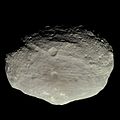| Name | Diameter (km) | Discovered | Comment |
|---|
| 1 Ceres | 939 | January 1, 1801 | First asteroid discovered |
| 5 Astraea | 117 | December 8, 1845 | First asteroid discovered after original four (38 years later) |
| 20 Massalia | 136 | September 19, 1852 | First asteroid named after a city (Marseille) |
| 45 Eugenia | 202 | June 27, 1857 | First asteroid named after living person |
| 87 Sylvia | 261 | May 16, 1866 | First asteroid known to have more than one moon (determined in 2005) |
| 90 Antiope | 80×80 | October 1, 1866 | Double asteroid with two nearly equal components; its double nature was discovered using adaptive optics in 2000 |
| 216 Kleopatra | 217×94 | April 10, 1880 | Metallic asteroid with "ham-bone" shape and 2 satellites |
| 243 Ida | 56×24×21 | September 29, 1884 | First asteroid known to have a moon (determined in 1994) |
| 243 Ida I Dactyl | 1.4 | February 17, 1994 | Moon of 243 Ida, first confirmed satellite of an asteroid |
| 279 Thule | 127 | October 25, 1888 | Orbits in the asteroid belt's outermost edge in a 3:4 orbital resonance with Jupiter |
| 288 Glauke | 32 | February 20, 1890 | Exceptionally slow rotation period of about 1200 hours (2 months) |
| 323 Brucia | 36 | December 22, 1891 | First asteroid discovered by means of astrophotography rather than visual observation |
| 433 Eros | 13×13×33 | August 13, 1898 | First near-Earth asteroid discovered and the second largest; first asteroid to be detected by radar; first asteroid orbited and landed upon |
| 482 Petrina | 23.3 | March 3, 1902 | First asteroid named after dog |
| 490 Veritas | 115 | September 3, 1902 | Created in one of the largest asteroid-on-asteroid collisions of the past 100 million years |
| 588 Achilles | 135.5 | February 22, 1906 | First Jupiter trojan discovered |
| 624 Hektor | 370×195 | February 10, 1907 | Largest Jupiter trojan discovered |
| 719 Albert | 2.4 | October 3, 1911 | Last numbered asteroid to be lost then recovered |
| 935 Clivia | 6.4 | September 7, 1920 | First asteroid named after flower |
| 1090 Sumida | 13 | February 20, 1928 | Lowest numbered asteroid with no English Wikipedia entry |
| 1125 China | 27 | October 30, 1957 | First asteroid discovery to be credited to an institution rather than a person |
| 1566 Icarus | 1.4 | June 27, 1949 | First Mercury crosser discovered |
| 2309 Mr. Spock | 21.3 | August 16, 1971 | First asteroid named after cat |
| 3200 Phaethon | 5 | October 11, 1983 | First asteroid discovered from space; source of Geminids meteor shower. |
| 3753 Cruithne | 5 | October 10, 1986 | Unusual Earth-associated orbit |
| 4179 Toutatis | 4.5×2.4×1.9 | January 4, 1989 | Closely approached Earth on September 29, 2004 |
| 4769 Castalia | 1.8×0.8 | August 9, 1989 | First asteroid to be radar-imaged in sufficient detail for 3D modeling [25] |
| 5261 Eureka | ~2–4 | June 20, 1990 | First Mars trojan (Lagrangian point L5) discovered |
| 11885 Summanus | 1.3 | September 25, 1990 | First automated discovery of a near-Earth object (NEO) |
| (29075) 1950 DA | 1.1 | February 23, 1950 | Small chance to collide with Earth in 2880 (1 in 2,600 or 0.039%) [26] |
| 69230 Hermes | 0.3 | October 28, 1937 | Named but not numbered until its recovery in 2003 (65 years later) |
| 99942 Apophis | 0.3 | June 19, 2004 | First asteroid to rank greater than one on the Torino Scale (it was ranked at 2, then 4; now down to 0). Previously better known by its provisional designation 2004 MN4. |
| 152830 Dinkinesh I Selam | 0.22 | November 1, 2023 | First satellite discovered to be a contact-binary |
| (433953) 1997 XR2 | 0.23 | December 4, 1997 | First asteroid to rank greater than zero on the impact-risk Torino Scale (it was ranked 1; now at 0) |
| 1998 KY26 | 0.030 | June 2, 1998 | Approached within 800,000 km of Earth |
| 2002 AA29 | 0.1 | January 9, 2002 | Unusual Earth-associated orbit |
| 2004 FH | 0.030 | March 15, 2004 | Discovered before it approached within 43,000 km of Earth on March 18, 2004. |
| 2008 TC3 | ~0.003 | October 6, 2008 | First Earth-impactor to be spotted before impact (on October 7, 2008) |
| (706765) 2010 TK7 | ~0.3 | October 2010 | First Earth trojan to be discovered |
| 2014 RC | ~0.017 | September 1, 2014 | Asteroid with fastest rotation: 16.2 seconds |





































